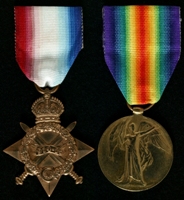

(L to R) 1914-15 Star; Allied Victory Medal
Godfrey was born in around May 1877 in Aberdeen, Scotland. His father was called Lawrence and his mother was Jane. He had 3 older siblings that we know of; Lawrence, Kathleen and Alice, and one younger sister called Charlotte. The family were members of the Church of England.
Lawrence was a soldier, so the family had travelled around the country, and each child had been born somewhere different. He died in around 1879 or 1880, aged around 27. In 1881 Jane and her children lived at 3 Ellis Court in Portsmouth, Hampshire. Jane worked as a tailoress.
We don't know anything about Godfrey's life until the autumn of 1894. He still lived in Portsmouth, we believe at 12 Durham Street. He had followed in his mothers footsteps and worked for Mr Hawkins as a tailor.
On the 11th October Godfrey joined the 3rd Battalion of the Hampshire Regiment. This was a unit of the Militia, so he kept his civilian home and job and trained as a soldier for a short period every year. When he enlisted Godfrey was 5 feet 4 3/4 inches tall and weighed 110 pounds. He had a 'fresh' complexion, grey eyes and dark brown hair. He also had 'G.W. + Cross tattooed on right forearm'.
Godfrey was given the service number 4952. He began his service with 49 days of drill and training. Godfrey left the Hampshire Regiment before his first annual training period. He transferred to the 3rd Battalion of the Manchester Regiment on the 1st April 1895.
In February 1896 we know that Jane lived at 26 Bridgewater Street in Manchester, so it is possible Godfrey had moved north with her and transferred regiments for this reason. Godfrey attended the Manchester Regiment's 1895 training period.
Godfrey was still a member of the Militia when he decided to join the Regular Army. He chose to join the Hampshire Regiment and travelled back to Portsmouth to enlist on the 20th February 1896. They gave him the service number 4799.
Since he joined the Militia Godfrey had grown by 1 1/8 inch and gained 8 pounds. His complexion was now 'florid', and oddly, his eyes were described as brown and his hair as black.
Godfrey trained at the Hampshire Regiment Depot in Winchester for almost 5 months. He was posted to the 2nd Battalion at Birr in County Offaly, Ireland on the 7th July.
Godfrey's conduct was 'Good', but his career was short. On the 19th February 1897 he was admitted to the Royal Infirmary in Dublin. He was suffering from flat feet. On the 'second day of route marching' Godfrey 'completely broke down'.
When he arrived in hospital it was found that 'arch of instep completely absent. Ankle bent inwards'. Godfrey was 'quite unfit to perform the ordinary duties of a soldier'. The doctors believed his condition was congenital and 'not aggravated by his service as a soldier'. They recommended he should be medically discharged.
This happened on the 27th March. Godfrey had served for 1 year and 36 days.
We don't know anything about Godfrey's life until 1901. When that year's Census was taken he lived at 23 Onslow Street in Leicester with the Brown family. He had returned to his old trade and was working as a tailor's presser.
By mid 1903 Godfrey was back in Manchester and living at 17 Russell Street. Emily Hutchins lived at number 10, and on the 1st June they got married at All Souls Parish Church.
By 1911 Godfrey and Emily had had 4 children, although 2 had died. We know one of these was Laurence Isaac. He was born on the 8th August 1906 and died between April and June 1907.
The 2 who survived were John Godfrey, who was born on the 13th November 1907 and Herbert, who was born on the 22nd April 1910.
From around 1910 onwards Godfrey worked as a tailor for Messrs David Moseley and Sons. They manufactured waterproof clothing at their factory on Dolphin Street in Ardwick, Manchester.
When the 1911 Census was taken in early April Emily and the children were living at 14 Forbes Street in West Gorton, Manchester. They shared the house with Godfrey's mother Jane and his sister Kathleen and her family. She was married to Stephen Todkill and they had a son named Stephen Godfrey. Godfrey himself was not there the night the Census was taken, although we don't know whether this was a permanent arrangement.
Godfrey and Emily had another son, Charles Alfred, on the 21st March 1912. The family lived at 77 Henly Street when he was born. By May 1913 they had moved again, to 14 Cobden Street. Harold was born here on the 22nd. Sadly he died in early 1914.
The First World War broke out in August 1914 and Godfrey joined the Army on the 13th January 1915. He decided to join the 1st City Battalion. This was being formed by the men of Manchester so that they could serve together.
This unit became the 16th Battalion of the Manchester Regiment and Godfrey was assigned to XVIII Platoon in E Company. His service number was 7376. He was still at 14 Cobden Street and working as a tailor when he enlisted.
Godfrey was apparently 'generally known as George'. This was the name recorded on his 1915 enlistment papers. Godfrey would later state that he reported the mistake at the time, but his service record was never changed.
This caused some confusion when Godfrey John junior was born on the 21st August 1915. The Army paid soldiers an extra allowance for each of their children, so they were quite keen to learn why the man they knew as George was claiming this allowance for a baby whose father's name was Godfrey!
Godfrey and the 16th Battalion trained in the UK at Heaton Park, Manchester until April 1915, then at Belton Park near Grantham, Lincolnshire until September when it moved to Larkhill in Wiltshire. On the 8th November the Battalion was sent to France.
In January 1916 Godfrey moved to the Somme sector of the front with the 16th Battalion. He spent the first half of the year rotating between the trenches and the rear areas. A large offensive was planned for this sector, so during June he left the front and took part in large scale training for this attack.
The Somme Offensive began on the 1st July, and Godfrey is likely to have taken part in the 16th Battalion's attack on Montauban that day.
The Battalion took part in more fighting during July, at Trones Wood on the 9th. They attacked the wood at 6:40am. They had captured it within 2 hours, but they were then bombarded by German artillery. Casualties increased and the battalion was forced to fall back. They advanced into the wood again 12 hours after the first attack began. They again captured it, and held their new positions until they were relieved on the 11th.
Godfrey was wounded in the left leg during this fighting. We believe he was hit on the 9th. After treatment in France he was evacuated back to the UK on the 17th July.
We don't know anything about what Godfrey did until May 1917. On the 24th he was transferred to Alder Hey Orthopaedic Hospital in Liverpool, although we don't know where he was transferred from.
Godfrey was treated here until the 14th November. He was graded as fit for 'employment', meaning he was able to do some work, but not military duty. He went home on leave to 183 Cobden Street until the 24th.
The next record we have of Godfrey is when he was discharged from the 2nd Western General Hospital in Manchester. This took place on the 18th December. We don't know when he had been admitted.
Godfrey was then sent to the 3rd Battalion of the Manchester Regiment at Cleethorpes in Lincolnshire. This unit held men who were completing their recovery and needed to be retrained.
After a few months it was clear that Godfrey would never be fit enough to return to duty. He was discharged on the 25th February 1918 as 'no longer physically fit for war service'. We believe he was awarded a Silver War Badge to show that his discharge was honourable. We don't know its serial number.
Godfrey qualified for a pension because of his wounds. He was awarded 27 shillings and 6 pence (27/6) for 4 weeks, then 8/3 per week for 48 weeks. We don't know whether he received any more money after this first year.
Shortly after the end of the war the National Publishing Company began an attempt to print a roll covering every man who had served in the First World War. They invited veterans or their families to send a short account of his or her service, for a fee. Not all veterans took up this offer, and the details they included were not checked for accuracy. Godfrey sent this biography to the Company. It was published in Section XI, Manchester, of the National Roll of the Great War:
Waters, G., Private, 16th Manchester Regiment.
Volunteering in January 1915, he trained at Heaton Park, and in July 1916 was sent to the Western Front. There he was in action at the Battle of the Somme, and was wounded and evacuated to England. Three months later he returned to the fighting line, and saw service in the Neuve Chapelle and Vimy Ridge sectors. He remained in France until demobilised in November 1919, holding the 1914-15 Star and the General Service and Victory Medals.
183, Cobden Street, Ancoats, Manchester.
The rest of Godfrey's life remains a mystery. His medals were donated to the Museum of the Manchester Regiment in August 1997. As well as his 1914-15 Star and Allied Victory Medal, Godfrey was also awarded the British War Medal for his Army service.




